Siamese Ships of World War I
กองทัพเรือไทย – Kong Thap Ruea Thai – The Royal Thai Navy in 1914-1918
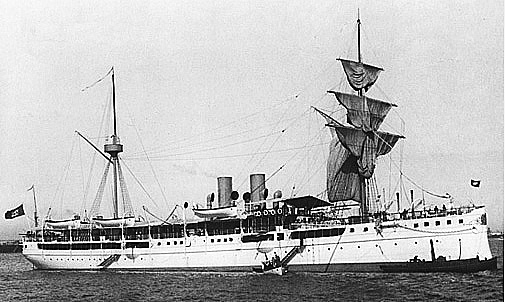
In 1860 the first modern ship of the Siamese fleet was bought from France: The steam Formosa, converted into a gunboat, and followed 5 years later by a corvette, 4 other gunboats and other light ships. It is a Dane of Huguenot origin, the admiral of Richelieu, who commanded the Siamese fleet until 1903. The fleet was thus constituted and trained by Danish and Norwegian officers, and this until 1914.
The Chaoh River Praya was defended by three forts, which meant access to the port and the arsenal of the fleet by enemy forces. The Bangkok Arsenal was reinforced with work to build new units and was comprehensive enough to accommodate and maintain an impressive fleet. However, in 1914 the Siamese fleet was of low military value because it consisted of units of civilian origin with little heavy weaponry. The training of the crews, however, was excellent, and local officers were trained in a naval academy founded in 1920.
Neutral until 1917, Siam declared war on the central empires and took advantage of it to integrate a number of German merchant ships.
3 Cruisers: Maha Chakri (1892), Thoon Kramon (1866), Makut Rajakumarn (1887). Note: Maha Chakri also served as Royal Yacht. Thoon Kramon was a small mixed vessel used as a training ship. Its value as a cruiser only existed on paper. Both ships were dropped from the lists in 1916.
2 Destroyers: Class Sua Thayan Chon (model Harusame, built in Japan in 1908 and 1912).
9 Miscellaneous: 2 Muratha class gunboats (1900), Theva Sooraram (1898), Suriya Monthon (1907), 4 No. 1 class torpedo boats (1908, Nippon const.), Prap Porapak patrolman (1899).
Postwar Additions: The armed yacht Maha Chakri, built in Japan and launched in 1918 to replace the first, and the destroyer Phra Ruang acquired in 1920 from the Royal Navy.
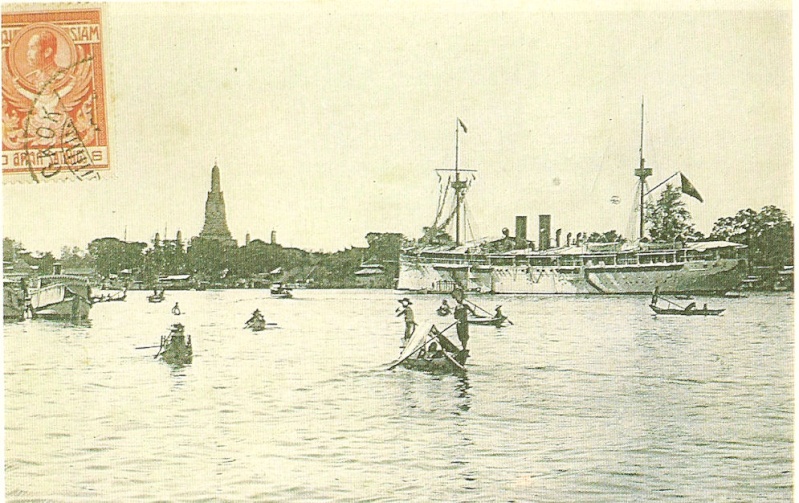
The Franco-Thai war of 1893
With the French operations against China and conquest of Tonkin, future Vietnam, Laos and Cambodia in the 1880s, tensions grew with the Siamese Kingdom, reaching boiling point in 1892. Everything will precipitate at the start of 1893, with the the suicide of Mr. Massie (Luang Phrabang’s vice-consulate), encroachments of Siamese troops along the Annamitic range, overlooking Annam. In May 1893 French and Siamese troops skirmished along the Mekong River for the control of Khone and Khong. Captain Thoreux was taken prisoner and in June 1893, the French administrator Grosgurin was massacred along with his Annamese escort, which gradually French opinion. Admiral Humann, Commander-in-Chief of the Far East Naval Division decided after a request from resident governor Auguste Pavie, to set up “a show of force” right in front of the Siamese capital, sending the gunboats Inconstant, Comet and Lutin, to be anchored in front of the France Legation in, Bangkok at the occasion of the National Day.
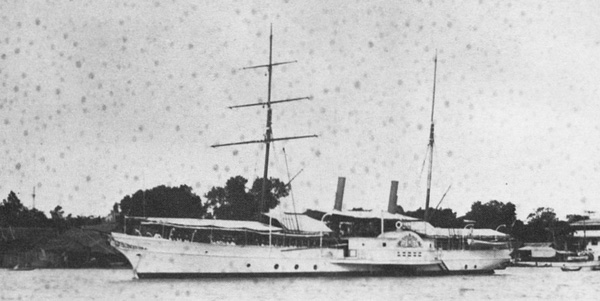
The French expedition
It was raining on this late afternoon, July 13, 1893, as the ships passed the bar at the mouth of the Menam with a sinister dark sky and creepy, howling wind. With the tide high enough, the three French ships (with the small steamer of the messageries (postal services) Jean-Baptiste Say went on, armed overall with eight medium caliber guns, seven Hotchkiss 37 mm revolver guns. At the end of the day, one Siamese pilot showed up to lead the way while they were spotted and shadowed by a Siamese wheeled Aviso, Akaret. One emissary asked to board the largest French ship, the sloop Inconstant. This was the German Commander Vill, in service of Siam which mission was to dissuade Commander Bory to pass the helm. The pilot was ordered not to send any information, while Time was running out and Commander Bory gave orders to set sail anyway. At 6:00 p.m., J.B. Say was leading the line, followed by Inconstant and Comet at the rear. The flotilla advanced between fisheries and the black buoy when at 6.30 p.m. the guns from the western point fort blazed out. These were modern armstrong guns able to reach 8,000 m.
Siamese fortifications
The Siamese rulers Rama II and Rama III feared earlier in the 19th century the expansionism of Vietnamese and Cambodians and built six military strongholds along the Chao Phaya River, in advance of Bangkok. These forts however were never properly maintained and crumled over time. In July 1856, Charles de Montigny arrived in Siam to sign a trade agreement with France, describing the sight of the mouth of the Menam. Her remarked the Siamese had raised a battery to defend the entrance to the river surrounded by brick walls and hidden from view, by a thick curtain of bamboo and mimosas. Paknam had two other fortresses, on each bank. One of these two islets carried the large chedi and the other the battery dated fom 1852, looking like a fortified temple with a row of cannons facing the river. The pass was extremely well guarded indeed. These were not the only ones, Edmond du Hailly recounts in 1866 trip to deliver letters from the Emperor Napoleon III to the two kings of Siam. He described Paknam as “abandoned, but not ruined”. Elisée Reclus in his geography of 1883 also indicated “fortresses and their grazing batteries” controlling the pass, he assumed for formerly Dutch, masters of the mouth, known by the British as ‘Dutch Follies’.
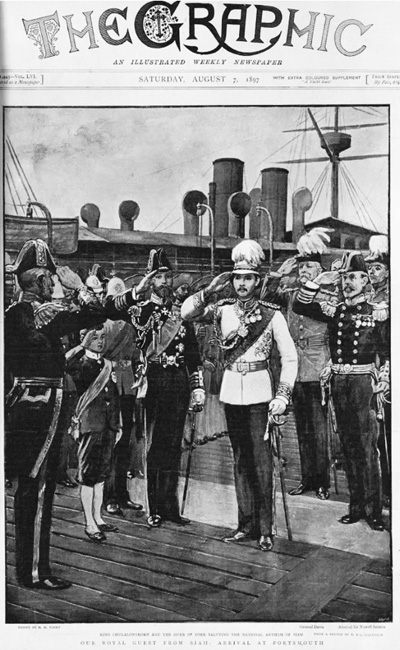 It was King Rama V Chulalongkorn worried about demonstrations from local colonial powers, to rehabilitate this essential line of defense and two forts were entirely rebuilt, Phra Chulachomklao (mouth western point) Phi Seua Samout, a little higher up the river, right bank close to Samut Prakan. In 1893, so just before the French launched their expedition, the king had these two forts equipped with a formidable, modern battery purchased to Vickers. These were brand new Armstrong 8-inches (21 cm), breech-loaded, with hydraulic return arms allowing a quick return in position and hiding them completely. They were indeed installed at the bottom firing well which negated anything but almost vertical shrapnel fire. All was done in brick masonry. When reloaded, their swing arm mount allowed them to be sheltered from standard, stright ar slight parabolic counter-battery fire. This system was proven and trigerred a wave of modern fortifications equipped the same way around the world.
It was King Rama V Chulalongkorn worried about demonstrations from local colonial powers, to rehabilitate this essential line of defense and two forts were entirely rebuilt, Phra Chulachomklao (mouth western point) Phi Seua Samout, a little higher up the river, right bank close to Samut Prakan. In 1893, so just before the French launched their expedition, the king had these two forts equipped with a formidable, modern battery purchased to Vickers. These were brand new Armstrong 8-inches (21 cm), breech-loaded, with hydraulic return arms allowing a quick return in position and hiding them completely. They were indeed installed at the bottom firing well which negated anything but almost vertical shrapnel fire. All was done in brick masonry. When reloaded, their swing arm mount allowed them to be sheltered from standard, stright ar slight parabolic counter-battery fire. This system was proven and trigerred a wave of modern fortifications equipped the same way around the world.
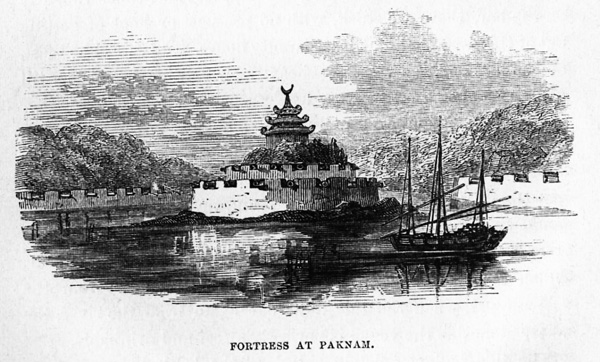
Paknam Fortress as described in the 1880s.
Thai guns were locally compared to “tiger crouching before pouncing on its prey”. They were manufactured in 1886 and perfectly well maintained with a supply of rounds but the crews seldom practiced. Seven were installed at the the southern fort (Phra Chulachomklao) and 3 at the island fort (Samut Prakan). By an astonishing coincidence, Dartige du Fournet recounted his visit three months earlier on April 11 from the gunboat Comet at Paknam, witnessing King Chulalongkorn’s inspection of the defenses paid 800,000 ticals from his own cassette. He describe as “brand new European fort armed with eight large Armstrong calibers”. Of course a demonstration was held with blank rounds, all eight fired, and at each detonation, Dartige du Fournet recalled the Comet vibrating under his feat… He would certainly had adviced against any expedition going through.
The Siamese fleet in 1893:
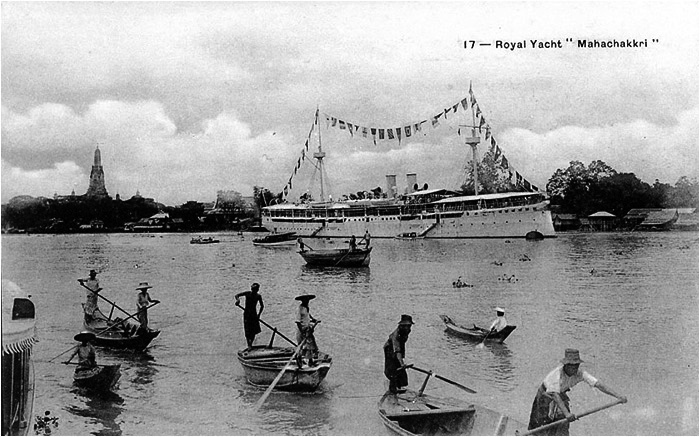
To him, the new cruiser Maha-Chakri carrying the head of staff seems equally formidable, with twenty Armstrongs and Hotchkiss revolver guns, dwarving the Comet, and he remarked also the modern “cruiser” Makut-Rajakhuma nearby. The King surrounded himself with specialists from Europe and his fleet manned or adviced by Danish and German sailors. On July 13, 1893, European officers saw the fleet in the Chao Phaya estuary, the gunboat Han Hak Sakru (Captain Smeigloff), the gunboat Monkut Rajakumar (Guldberg), the gunboat Coronation (Christmas) and two more gunboats, Nirben and the Maïda plus the armed rowboats Ko Si Chang, Gladys and Fylla. The southern fort was under command of Danish officer Carl Von Holck. However Siamese artillerymen never had the opportunity to fire yet, and sailors were requisitioned peasants more accustomed to their paddy fields, and often Cambodians of dubious loyalty. European Officers which rarely spoke Siamese had an ambiguous status and had a hard time maintaining discipline and motivating their crews. The whole fleet was under orders of a Frenchman, Commodore Armand du Plessis de Richelieu, which received the title of “Phraya Cholayuth Yothin”. The whole force amounted 2,000 men.
Operations
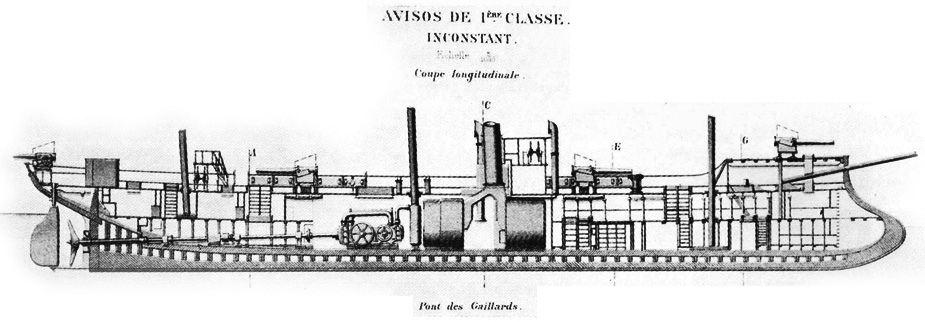
Plan of the French Sloop Inconstant, admiral ship of the expedition
Dartige du Fournet related the way it unfolded: French vessels were targeted by the southern fort, Inconstant was the only really powerful French vessel at the time: The Toulon-built 1886 vessel was the lead ship of her class (also comprising Fulton and Papin), and a masted sloop, with a dislacement of 887 tons standard. She was capable of 12 knots with her HC compound engine with six cylindric boilers for 1,100 ihp. Armament was limited to three 5.5 inches/30 M1881 guns (140 mm) and a single 3.9 inch (100 mm) plus five 1-pdr Hotchkiss revolver guns (37 mm). She was outranged by the fort’s guns and matched by the cruiser Maha Chakri. She replied to the fort.
The southern fort of Phra-Chula was soon covered in lightning and smoke but its fire was accurate and the recoil system had them effectively eclipsed into their masonry shafts in between fire. French sheels bounced harmlessely on the thick masonry walls, until the captain order its cannons to be loaded with grape-shot an fuses rounds. The shrapnel exploded right above the heads of the servants, both killing or injuring them and disrupting the guns mechanisms. Meanwhile, the French were still not hit, and continued to close in while still travelling silently.
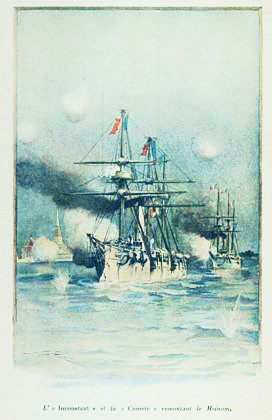 However Suddenly Jean-Baptiste Say came to port, just after receiving a shell, and had to beach on the left bank. Another shell burst aboard the Inconstant, killing the master carpenter instantly and Commander Bory decided to steer straight through the middle of the estuary and took position for a broadside at 6:43 pm. Navigation was difficult since the 600-800 meters passage was obstructed by Siamese obstacles, from old sunken junks, stakes driven into the mud and linked by chains, leaving only a free channel of about 80 meters wide. The two remaining French ships charged through while Siamese ships on either side of the channel started to open fire as well. Behind this, the Danes had installed the ultimate obstacle, a line of torpedoes setup and managed by engineer Westenholz, director of Bangkok’s electric trams. However when they approached, the French ships were engulfed in smoke and were close enough now to hear the distinct crackle of machine guns and crash of cannonade and point-blank gunfire explosions. However eventually it seemed the Siamese panicked, the Europeans officers had to man the guns themselves, loosing time, loading and pointing the guns while lending a hand to the steering on the ships.
However Suddenly Jean-Baptiste Say came to port, just after receiving a shell, and had to beach on the left bank. Another shell burst aboard the Inconstant, killing the master carpenter instantly and Commander Bory decided to steer straight through the middle of the estuary and took position for a broadside at 6:43 pm. Navigation was difficult since the 600-800 meters passage was obstructed by Siamese obstacles, from old sunken junks, stakes driven into the mud and linked by chains, leaving only a free channel of about 80 meters wide. The two remaining French ships charged through while Siamese ships on either side of the channel started to open fire as well. Behind this, the Danes had installed the ultimate obstacle, a line of torpedoes setup and managed by engineer Westenholz, director of Bangkok’s electric trams. However when they approached, the French ships were engulfed in smoke and were close enough now to hear the distinct crackle of machine guns and crash of cannonade and point-blank gunfire explosions. However eventually it seemed the Siamese panicked, the Europeans officers had to man the guns themselves, loosing time, loading and pointing the guns while lending a hand to the steering on the ships.
Evetually everything calms down, as the French ships have passed at around 7:00 p.m. Inconstant lights turn on as the darkness fell, and the two ships speed up towards Bangkok, fearing another ambush. But there was none. The fight only lasted half an hour and inhabitants from Bangkok heard the explosions. Eventually as planned, the two ships, Inconstant and Comet, drop anchors in front of the Royal Palace. “Gunboat Diplomacy” was about to do its job, again. The crossing was not really a “naval batte” in traditional sense as discipline soon broke out and officers were obliged take on their job and were quickly overworked, hampring both accuracy and rate of fire. The ships were almost useless, but not the forts. Better disciplined, the crews behaved superbly and fired well, but still accuracy was poor, just just two hits for over ten minutes of battle at close range. The lack of training was a crucial issue. In the end, this crossing of the Mekong was the only French-Thai naval action of that era. The Thai Navy was not tested until 1941, against its old foe, again, at Kho Chang.
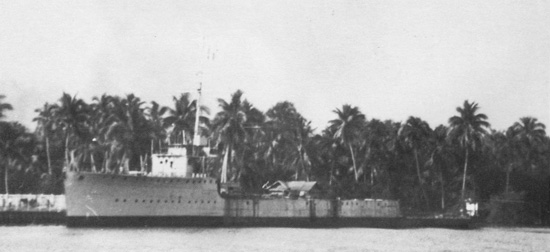
The destroyer Phra Ruang (acquired 1920), stil active in WW2.
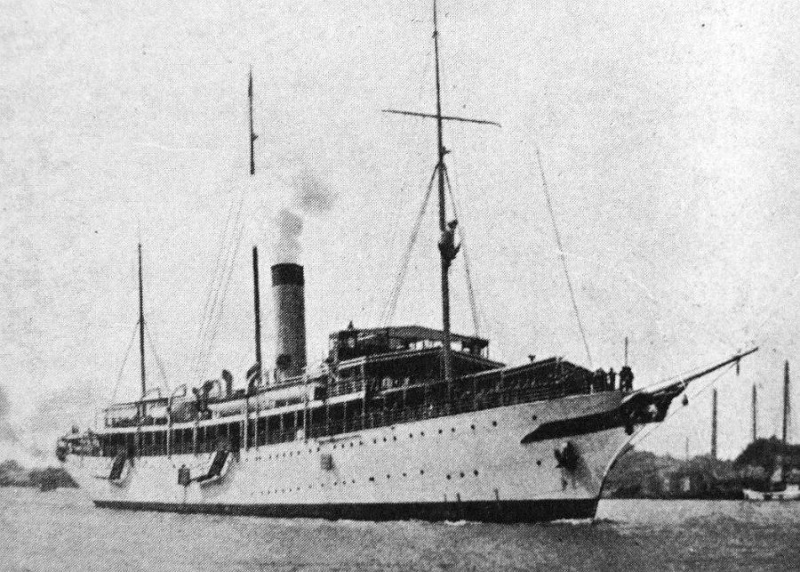
The Armed Yacht Maha Chakri (1918). She resurrected the name of the previous cruiser, ordered after a public subscription was raised. She reused the previous cruiser’s steam engines and fittings, dismantled from 1916. The new ship was built in Kawasaki Yard, Kobe, completed after WWI. She was re-rated as a transport in 1936, then a depot ship for submarines, renamed Angthong, and she was active in WW2, stricken in 1952.
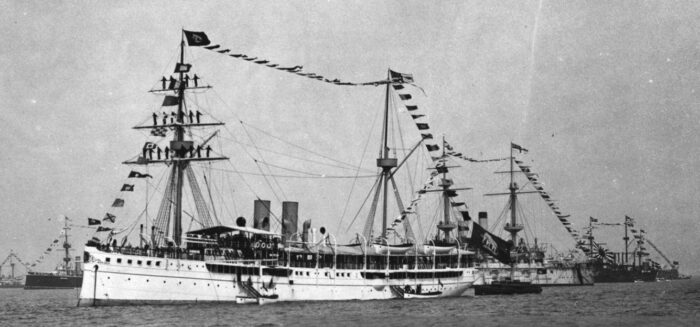
Maha Chakri in full regalia at Queen Victoria’s diamond Jubilee, Spithead 1897 (reddit). Note: There are not enough info to tackle the subject yet.
Read More
Conway’s all the world’s fighting ships 1860-1905
Conway’s all the world’s fighting ships 1906-1920
Dr. Stephen S. Roberts, Warship International, N°3, 1986
https://victoriantrail.co.uk/chulalongkorn-rama-v/
https://www.le-souvenir-francais-thailande.com/le-conflit-franco-siamois-de-1893
http://www.thailandshistoria.se/artiklar/17/21/bangkok,-%3Cbr/%3Erama-i-rama-vii/kung-chulalongkorn/krisen-1893-och-handelserna-i-bangkok
https://siamrat.blog/2020/08/05/the-day-king-chulalongkorn-met-queen-victoria/
https://laststandonzombieisland.com/2019/08/07/warship-wednesday-aug-7-2019-the-muddy-seabird-of-manila-bay/htms-makut-rajakumarn-nh-94239/
https://stefsap.wordpress.com/2015/12/07/the-thai-navy/
https://pantip.com/topic/34415129
The Thai fleet in detail
It might be surprising, but Siam had the third largest Asiatic navy on paper, with three cruisers, six gunboats (incl. one armoured ordered, but delivered after the war), two destroyers, four TBs, one armed yachts and one dispatch vessel. Two of these cruisers were all sub-par and glorified gunboats, and the armament was standardized to the 4.7 inches Armstrong guns.
Tonnage 1914: Cruisers: 3 – Destroyers: 2 – Various: 9
Cruiser Maha Chakri (1892)
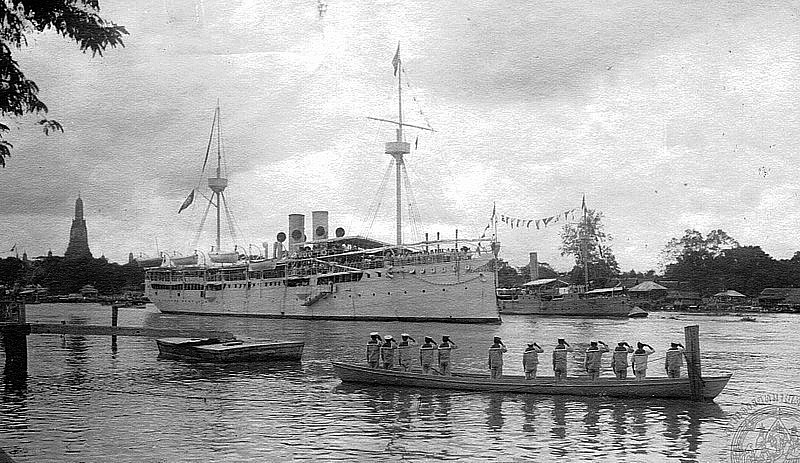
Maha Chakri, src thaiseafarer.com
Ordered to British yard Leith, this steel-hulled protected cruiser was given a ram bow, two masts and two funnels. She was armed with four single Armstrong 120mm guns (4.7 inches) placed in the upper deck sponsons amidships.
Protection was limited to a 51 mm protective deck, probably flat. Maha Charki was completed in 1893 and fitted out as Royal Yacht in peace time, but protected cruiser in wartime (fixtures were to be removed, equipments, supplies added). She did not took part in WWI under neutrality status and in 1917, both her engines and fittings were taken out. She was indeed discarded and scrapped in 1917, most of her being recycled and reused into the next Japanese, Kawasaki-built yacht/cruiser of the same name in 1918.
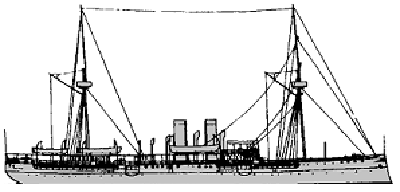
Specifications |
|
| Dimensions | 88.4 x 12 x 4.19 m (520.16 x 54 x 21 ft) |
| Displacement | 2,500t; 2,900 t FL |
| Crew | 318 |
| Propulsion | 2 shaft VTE 5 cyl. Boilers 3000 hp, 15 kts, 280 tons coal |
| Armament | Four 120mm/40 (4.7 in), ten 57mm/40 Hotchkiss (6 pdr) |
| Armor | 51 mm (2 in) armoured deck |
Cruiser Makut Rajakumarn (1887)
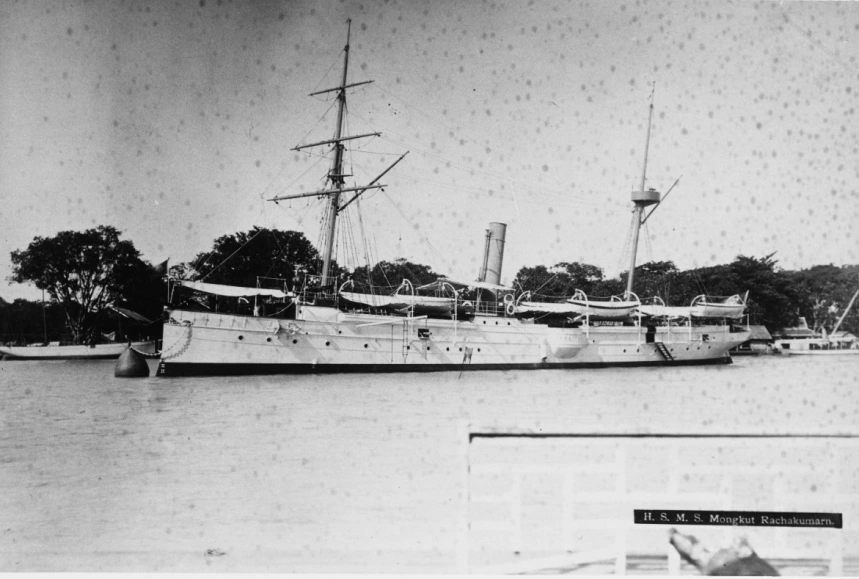
Photo by G.R. Lambert & CO. of Singapore, received by ONI in May 1892 from USS PETREL; probably at Bangkok. NH 94239
HTMS MAKUT RAJAKUMAR was Built in Whapoa yard in Hong Kong in 1887-88, at first to be sold to Spain, for her Philippines colony as “Filipinas”. She failed to make the contract speed and was rejected. Instead she was resold to to Siam in 1891. She was a steel schoner-rigged 650 tons vessel, 175 feet long, 14 knots armed with two 40pdr, five 20-pdr. She had two mainmasts with fighting tops, one funnel, one ram bow. Her armament was classic but heavy for a 700 ton ship with four different calibers and even included a torpedo tube. By 1905 she was not capable of more than 11 knots in service. Due to her heavy armament she was classed alternatively as cruiser and gunboat. She was extant in WWI but discarded in the 1930s.
Specifications |
|
| Dimensions | 53.34 x 7.16 x 3.35 m (175 x 23 x 11 ft) |
| Displacement | 700 tons standard |
| Crew | 100 (est.) |
| Propulsion | 2 shaft VTE, 2 Boilers 800 ihp, 14 kts, 90 tons coal |
| Armament | Two 120mm/40 (4.7 in), four 57mm/40 Hotchkiss (6 pdr), 3x 3-pdr, 1x 14 in TT |
| Armor | Unknown |
Cruiser Thoon Kramon (1866)
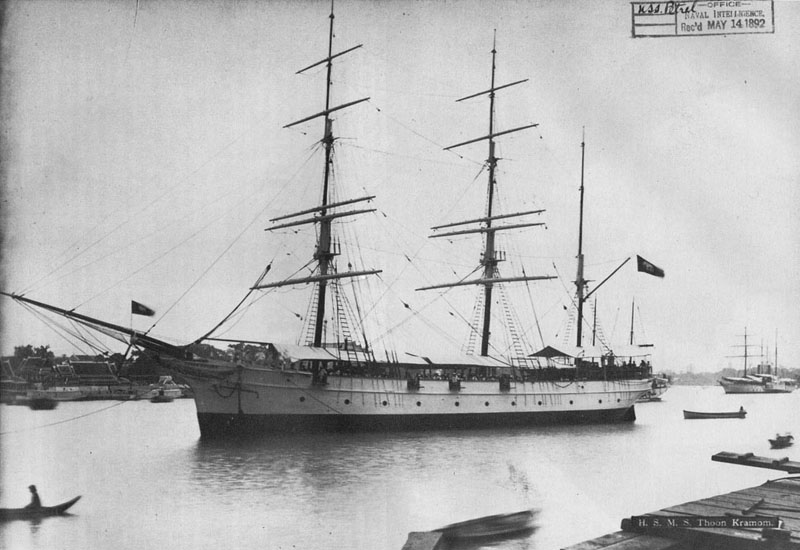
This fully-rigged barque ship belonged to the King of Thailand. This was a former trader with Europe, sailing her first, profitable trade trip after her purchase under the Danish captain H. N. Andersen in 1884. Her walls and main battery deck were backed by teakwood but not steel-armored. Her 1884 trip was considered the beginning of the Danish East Asiatic company, the captain establishing on site a trading business. Built 1866 in Bangkok, her displacement was 475 tons, and she measured 151 feets x 28 x 15. Owned by the Siamese Government she had as port of registry, Bangkok. Although there was conflicting evidence over her armament, but she was indeed listed as “cruiser”, with Danish officers and Siamese crews.
Sua Thayan Chon class destroyers (1908)
Sua Thayan Chon, Sua Khamron Sin.
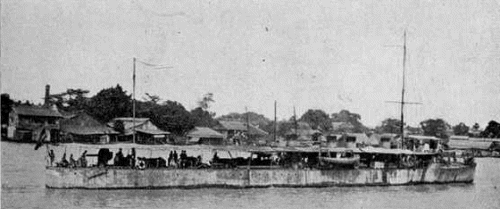
Sri Thayan Chon 1919 (src navypedia)
The only modern destroyers of the Thai Navy in 1914. Bith were Japanese-built, in Kobe, launched respectively in 1908 and 1912. A great gap, possibly to secure enough funds. Both were based on the Harusame class and were typical of the time, with a low freeboard, turtleback forward, four funnels, two masts, a single 3-in and fve 6-pdr, all Vickers, two MGs, and two centerline single torpedo tubes, 18-in caliber (357 mm). They also had pure oil-fired boilers. Both were discarded before WW2: The first was sold on 22.8.1939 and the second on 17.1.1937.
Specifications |
|
| Dimensions | 69.2 x 6.6 x 1.8 m (227 x 21.6 x 6 ft) |
| Displacement | 375 tons standard |
| Crew | 75 |
| Propulsion | 2 shaft VTE, 4 Kampon Boilers 6,000 ihp, 29 kts, 75 tons oil |
| Armament | 76mm (3 in), 5x 57mm (6 pdr), 2x MGs, 2x 18 in TT |
Thai gunboats
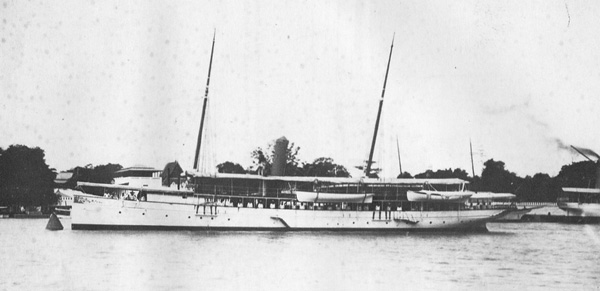
Ubon Borahit, dispatch vessel
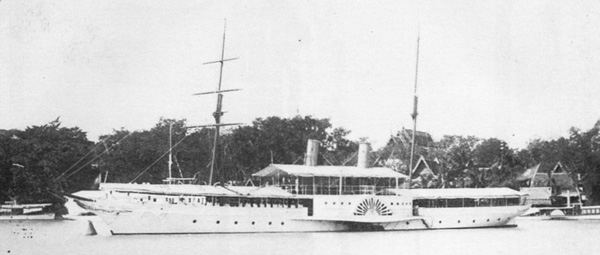
Armed Yacht Akaret Ratthanak
In the 1870-90s Siam operated the masted gunboats Yong Yot, Nirbben, Han Hak Sakru, Maida (discarded 1906-1910), Ran Ruk (1870), Kohe si Chang and Udhai Rajakich (1890), discarded in 1908 for the first, but possibly during WWI for the two others so they will be treated there. Maha Pichiaiathep (1867, 580t, 46×7.6×3.5, 1x70pdr, 4x 12pdr), Regent (1868, 660 tons, 50.6×7.92×3.2, 8x 12 pdr), the floating battery Siam Mougkut (1870, 950t, 64m, 2-1/2 in iron hull, 8×12-pdr) and the gunboat Ran Ruk (1897, 700t, 38.4×7.92×3.51, 4×4.7 in, 1×6-pdr, 3 TTS) were all discarded between 1912 and WWI. They could have still been active under some menial task.
Mongkut Rajakumarn (1887)
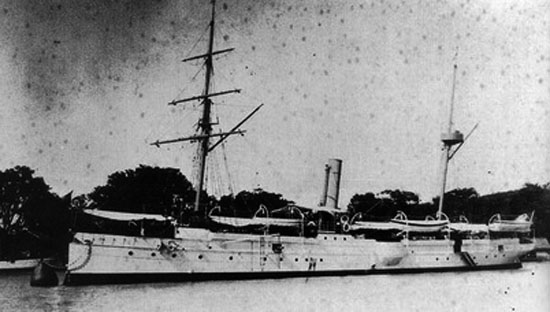
A steel-hulled gunboat, rigged as a schooner, two masts with military tops, one funnel and a ram bow. She was built in Whampoa for Spain (Philippines) and would have been named Filipinas, but was resold to Siam after failing to comply to the required speed. She was later reclassed as a cruiser (see above) despite she was way too small for one.
Muratha class gunboats (1900)
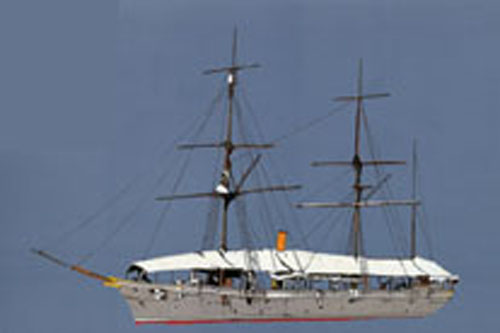
Muratha, Bali, Sugrib, were all steel-hull boats built in Hong Kong with a ram bow, two masts, one funnel, flush deck, one single 4.7 in BL mounted on the forecastle and five 6-pdr on sponsons amidships and four 1-pdr for quick firing mounted on a raised plateform close to the funnel. Quik specs: 530 to 580 tons, 44-49 m x 7 x 3 m (162 x 23 x 10 ft), 500 ihp CP engine, 11.4 kts, crew 83. They served until the 1930s.
Theva Sooraram (1898)
115 tons gunboat, running on coal, active in WWI, stricken June 1919. Little info available.
Suriya Monthon (1907)
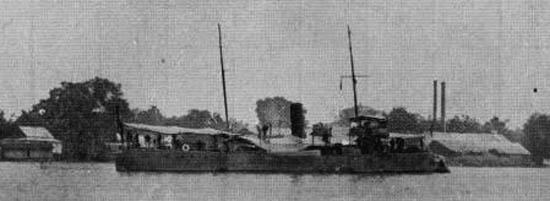
Sri Monthon was built in Thornycroft, Southampton, 1907-1908. Two masts, single funnel, low, flush deck, armed with two 6-pdr (57mm/40) Hotchkiss guns. Quickspecs: Displacement 225t, 39.6/41.8 x 5.50 x 2.00m, 2 shafts VTE, 1 Thornycroft boiler, 7,500 shp 15.5 kts, 66 tons coal, crew 34. Used for customs and board guard services. She was active during the interwar, stricken in June 1935.
Torpedo Ships
4 No. 1 class torpedo boats (1908)
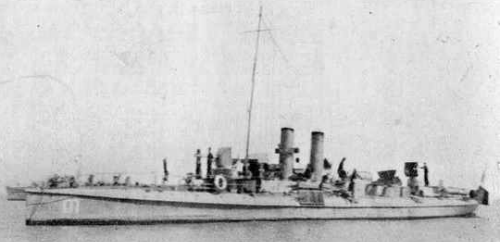
These four small 2nd class ships were built in Kawasaki, Kobe, in Japan, three laid down in 1907 and another in 1912, at the same time as a second destroyer. These were of the Normand-Kawaski design, close to the Hu-Peng class, oil-fired. They had a low freeboard and were seen as coastal vessels, based on the Mekong. Quick specs: Displacement 89/100 tons FL, 40.1/41.1m oa x 4.90 x 2.10m, 2 shafts, 1 VTE, 2 Kampon watertube boilers, 1200 shp, 23 kts, 19 tons oil, 1x 57mm/40 Hotchkiss, 1x 47mm/40 Hotchkiss, 2x 450 mm TTs (18 in), crew 24-29. In active service in WW2 they were still extant in the 1930s, sold 1933-37.
Siam also had a second class 45 tons TB built in 1888-89 but discarded after 1905. Built in Bangkok DYd she was called Moradoph. 22x 2.8 x 1.5m, 1 HDA, 1 locomotive boiler, 35 hp, 10 kts, she was wooden hulled and propelled a 1 spar torpedo.
Misc. Ships
Prap Porapak patrol boat (1898)
Built in Hongkong and Whampoa yards, this dispatch vessel launched and completed in 1898 displaced 210 tons. She was reclassed later as patrol boat, saw WWI and was stricken in 12.1929.
Links
thailan navy main on navypedia.org/
maha charki on navypedia.org/
commons.wikimedia.org/ Maha_Chakri
on reddit.com/ photo jubilee


 Latest Facebook Entry -
Latest Facebook Entry -  X(Tweeter) Naval Encyclopedia's deck archive
X(Tweeter) Naval Encyclopedia's deck archive Instagram (@navalencyc)
Instagram (@navalencyc)





 French Navy
French Navy Royal Navy
Royal Navy Russian Navy
Russian Navy Armada Espanola
Armada Espanola Austrian Navy
Austrian Navy K.u.K. Kriegsmarine
K.u.K. Kriegsmarine Dansk Marine
Dansk Marine Nautiko Hellenon
Nautiko Hellenon Koninklije Marine 1870
Koninklije Marine 1870 Marinha do Brasil
Marinha do Brasil Osmanlı Donanması
Osmanlı Donanması Marina Do Peru
Marina Do Peru Marinha do Portugal
Marinha do Portugal Regia Marina 1870
Regia Marina 1870 Nihhon Kaigun 1870
Nihhon Kaigun 1870 Preußische Marine 1870
Preußische Marine 1870 Russkiy Flot 1870
Russkiy Flot 1870 Svenska marinen
Svenska marinen Søværnet
Søværnet Union Navy
Union Navy Confederate Navy
Confederate Navy Armada de Argentina
Armada de Argentina Imperial Chinese Navy
Imperial Chinese Navy Marinha do Portugal
Marinha do Portugal Mexico
Mexico Kaiserliche Marine
Kaiserliche Marine 1898 US Navy
1898 US Navy Sovietskiy Flot
Sovietskiy Flot Royal Canadian Navy
Royal Canadian Navy Royal Australian Navy
Royal Australian Navy RNZN Fleet
RNZN Fleet Chinese Navy 1937
Chinese Navy 1937 Kriegsmarine
Kriegsmarine Chilean Navy
Chilean Navy Danish Navy
Danish Navy Finnish Navy
Finnish Navy Hellenic Navy
Hellenic Navy Polish Navy
Polish Navy Romanian Navy
Romanian Navy Turkish Navy
Turkish Navy Royal Yugoslav Navy
Royal Yugoslav Navy Royal Thai Navy
Royal Thai Navy Minor Navies
Minor Navies Albania
Albania Austria
Austria Belgium
Belgium Columbia
Columbia Costa Rica
Costa Rica Cuba
Cuba Czechoslovakia
Czechoslovakia Dominican Republic
Dominican Republic Haiti
Haiti Hungary
Hungary Honduras
Honduras Estonia
Estonia Iceland
Iceland Eire
Eire Equador
Equador Iran
Iran Iraq
Iraq Latvia
Latvia Liberia
Liberia Lithuania
Lithuania Mandchukuo
Mandchukuo Morocco
Morocco Nicaragua
Nicaragua Persia
Persia San Salvador
San Salvador Sarawak
Sarawak Uruguay
Uruguay Venezuela
Venezuela Zanzibar
Zanzibar Warsaw Pact Navies
Warsaw Pact Navies Bulgaria
Bulgaria Hungary
Hungary

 Bundesmarine
Bundesmarine Dutch Navy
Dutch Navy Hellenic Navy
Hellenic Navy Marina Militare
Marina Militare Yugoslav Navy
Yugoslav Navy Chinese Navy
Chinese Navy Indian Navy
Indian Navy Indonesian Navy
Indonesian Navy JMSDF
JMSDF North Korean Navy
North Korean Navy Pakistani Navy
Pakistani Navy Philippines Navy
Philippines Navy ROKN
ROKN Rep. of Singapore Navy
Rep. of Singapore Navy Taiwanese Navy
Taiwanese Navy IDF Navy
IDF Navy Saudi Navy
Saudi Navy Royal New Zealand Navy
Royal New Zealand Navy Egyptian Navy
Egyptian Navy South African Navy
South African Navy






























 Ukrainian Navy
Ukrainian Navy dbodesign
dbodesign